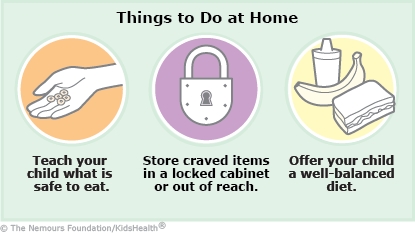Pica is when someone craves and eats things that aren't food. It can happen for different reasons and can last a month or sometimes longer. Children with pica (PIE-kuh) usually get better as they grow older. By helping your child avoid eating things they shouldn't, you can help keep them well.



Your child:

Your child:

Isn't it normal for kids to put things in their mouth? Young kids often put non-food items (like grass or toys) in their mouths because they're curious about the world around them. But kids with pica go beyond that and keep craving and eating things that aren't food even when parents try to get them to stop.
The non-food items that kids with pica crave vary, but may include things like dirt, clay, paint chips, chalk, feces (poop), plaster, coffee grounds, cigarette butts, glue, hair, sand, ice, or soap.
Why do some kids have pica? Doctors don't always know why someone has pica. Any child can have pica, but it's more common in kids with developmental problems like autism. It also can affect kids who aren't getting enough nutrition, have a lot of stress, or have obsessive-compulsive disorder (OCD).
Why does pica cause a problem? Eating non-food items can make it harder for kids to get the nutrients they need from food. It may also put a child at risk for lead or mercury poisoning, bowel problems, intestinal blockage or bleeding, tooth damage, or parasites.
How is pica treated? Treatment for pica includes teaching your child about what is safe to eat and keeping non-food items that your child craves out of reach. The health care provider might recommend a supplement for nutritional deficiencies (such as not enough iron or zinc). Sometimes, working with a psychologist or other mental health provider can help.